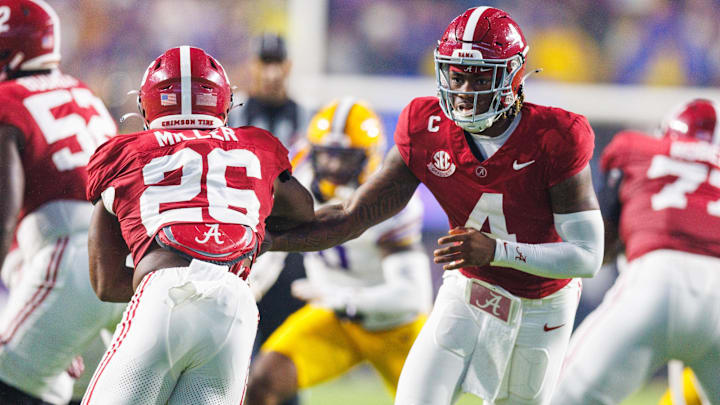Kalen DeBoer’s first season in Tuscaloosa didn’t live up to the lofty expectations that Nick Saban built for the Alabama football program. Still, with an expanded 12-team College Football Playoff, the Crimson Tide’s nine-win season was enough to reach the doorstep of meaningful postseason football.
Factions of the Alabama fanbase may be willing to give DeBoer a mulligan for Year 1, but his supporters will dwindle if he comes up short again in 2025. The Crimson Tide have to find their way into the CFP, or the temperature of DeBoer’s seat could reach the boiling point, and claiming a spot in the top 12 means avoiding dumbfounding losses to Vanderbilt and Oklahoma.
Those two upset losses came in very different ways for Alabama. Against Vanderbilt, Kane Wommack’s defense could not get a spot, but it was the offense that sputtered in Norman. Both sides of the ball need to take a step forward in 2025, but if you had to pick one thing to improve, it would be in the run game, which may appear to be a challenge with Jalen Milroe now in the NFL.
Run game efficiency could take Alabama’s offense to the next level
Milroe provided Alabama with a remarkable floor offensively, thanks to his ability to create explosive plays with both his arm and his legs. Milroe led the team in rushing with 726 yards and 20 touchdowns on 168 carries, and his sack-adjusted rushing total was 879 yards. However, the Milroe-centric run game, like the passing game, was feast or famine, finishing 89th percentile in explosive rush rate and 22nd percentile in stuff rate (runs stop at or behind the line of scrimmage). That former is exceptional, the latter is a massive problem.
In some ways, losing Milroe could level off both numbers. Without the most dynamic rushing quarterback in college football, explosive plays will be much tougher to come by on the ground. However, Milroe’s belief in his rushing ability and insistence on pulling the ball regardless of the read the defense gave him meant that too many run plays were destined to fail.
For example, the Oklahoma defense held Milroe to seven rushing yards on 11 carries with a long of just 11 yards. In Norman, 28 percent of Alabama’s run plays were held to zero or fewer yards, and nearly half were stopped for a gain of two or less. That run-game ineptitude led to an average third-down distance of nearly eight yards and three interceptions from Milroe.
While the former Alabama QB has some culpability for an alarmingly high stuff rate, he was still a net-positive on the ground. And with defenses constantly forced to account for him in the run fit, Alabama’s running backs, Jam Miller and Justice Haynes, didn’t take advantage nearly enough. Miller’s success rate of 40 percent ranked 151st in the country, and his -0.09 EPA/rush was 214th. Yet, with Haynes, who was less consistent but more explosive and produced a positive EPA/rush, off to Michigan in the transfer portal, Miller is firmly entrenched as RB1 for first-year starting quarterback Ty Simpson, assuming Simpson wins the job.
Simpson is not a threat in the run game, so the Crimson Tide will forfeit the advantage of 11-on-11 football. Still, there are reasons for optimism with the ground attack. After a one-year stint with the Seattle Seahawks, DeBoer’s long-time offensive coordinator, Ryan Grubb, finally joined his staff in Tuscaloosa.
The last time Grubb was a collegiate OC, he was helping DeBoer lead the Washington Huskies to the National Championship Game with a run game that ranked 25th in EPA/rush and 15th in rushing success rate with a completely stationary Michael Penix Jr. at quarterback.
Grubb’s Seahawks finished 28th in rushing offense last season, one of the big reasons why he’s back in the collegiate ranks now. Which version of his complex run-scheme shows up, and if he can find a way to get more out of Miller or whomever emerges as RB2, will largely determine his and his longtime boss's fate in Tuscaloosa.
